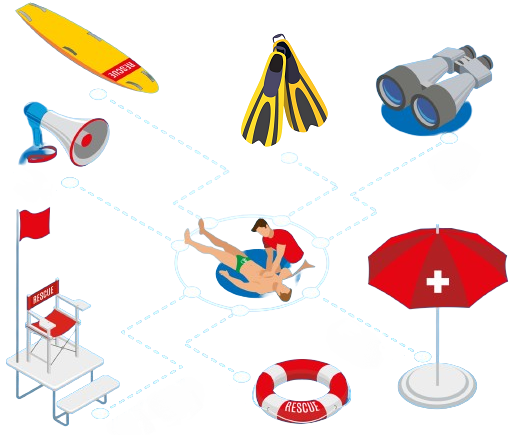As nadadeiras mais longas melhoram os salvamentos oceânicos?
Uma investigação abrangente sobre o desempenho do salva-vidas e o impacto fisiológico

Downloads
Palavras-chave:
Salvamento, Nadadeiras, Resgate Aquático, Lactato, Esforço, Salva-Vidas, Afogamento, águas abertasResumo
Os ambientes costeiros apresentam desafios dinâmicos que necessitam de respostas rápidas e eficientes durante emergências aquáticas. Os salva-vidas, como elos centrais da cadeia de intervenção, contam com diversas ferramentas, sendo o tempo de resgate primordial. A escolha das nadadeiras, especificamente as longas e as curtas, desempenha um papel crítico na otimização do desempenho do salva-vidas durante os resgates. Este estudo cruzado randomizado explora o impacto do tamanho das nadadeiras nos resgates oceânicos, empregando uma amostra de 14 salva-vidas. Nadadeiras longas (LFs) e nadadeiras curtas (SFs) foram comparadas em termos de tempo de resgate (TR) e carga fisiológica (PL). Os testes incluíram resgates oceânicos sem nadadeiras (R), com LF (R-LF) e com SF (R-SF). As variáveis registradas abrangeram o tempo de nado para aproximação, o tempo de reboque, o tempo geral de resgate, as taxas de esforço percebido (RPEs) e a concentração de lactato pós-resgate. Nadadeiras longas demonstraram desempenho superior para o nado de abordagem e nos tempos de reboque em comparação com nadadeiras curtas e sem nadadeiras (p < 0,001). O tempo geral de resgate foi favorecido significativamente pelas nadadeiras longas (p <0,001), indicando sua eficiência em cenários práticos de resgate oceânico. Fisiologicamente, nadadeiras longas induziram menor esforço percebido nos braços (p = 0,033) em comparação com nadadeiras curtas. As concentrações de lactato pós-resgate não revelaram diferenças significativas (p > 0,05). Este estudo demonstra que nadadeiras longas melhoram significativamente o desempenho do salva-vidas durante resgates no oceano, reduzindo o tempo de resgate e aliviando a fadiga dos braços.
Referências
(1) Szpilman D, de Barros Oliveira R, Mocellin O, Webber J. Is drowning a mere matter of resuscitation? Resuscitation. 2018 Aug;129:103–6.
(2) Szpilman D, Webber J, Quan L, Bierens J, Morizot-Leite L, Langendorfer SJ, et al. Creating a drowning chain of survival. Resuscitation [Internet]. 2014 Sep;85(9):1149–52. Available from: http://www.sobrasa.org/new_sobrasa/arquivos/baixar/Manual_de_emergencias_aquaticas.pdf
(3) Quan L, Wentz KR, Gore EJ, Copass MK. Outcome and Predictors of Outcome in Pediatric Submersion Victims Receiving Prehospital Care in King County, Washington. Pediatrics. 1990 Oct 1;86(4):586–93.
(4) Avramidis S, Butterly R, Llewellyn DJ. The 4W Model of Drowning. International Journal of Aquatic Research and Education. 2007 Aug;1(3).
(5) E.F. van Beeck, Branche CM, D. Szpilman, Modell JH, J.J.L.M. Bierens. A new definition of drowning: towards documentation and prevention of a global public health problem. PubMed. 2005 Nov 1;83(11):853–6.
(6) Suominen P, Baillie C, Korpela R, Rautanen S, Ranta S, Olkkola KT. Impact of age, submersion time and water temperature on outcome in near-drowning. Resuscitation. 2002 Mar;52(3):247–54.
(7) Barcala-Furelos R, Szpilman D, Palacios-Aguilar J, Costas-Veiga J, Abelairas-Gomez C, Bores-Cerezal A, et al. Assessing the efficacy of rescue equipment in lifeguard resuscitation efforts for drowning. The American Journal of Emergency Medicine. 2016 Mar;34(3):480–5.
(8) Cristian Abelairas-Gómez, Barcala-Furelos R, Mecías-Calvo M, Rey-Eiras E, López-García S, Costas-Veiga J, et al. Prehospital Emergency Medicine at the Beach: What Is the Effect of Fins and Rescue Tubes in Lifesaving and Cardiopulmonary Resuscitation After Rescue? Wilderness & environmental medicine. 2017 Sep 1;28(3):176–84.
(9) Morgan D, Ozanne-Smith J. Surf Lifeguard Rescues. Wilderness & Environmental Medicine. 2013 Sep;24(3):285–90.
(10) Venema AM, Groothoff JW, Bierens JJLM. The role of bystanders during rescue and resuscitation of drowning victims. Resuscitation. 2010 Apr;81(4):434–9.
(11) Dahl AM, Miller DI. Body contact swimming rescues--what are the risks? American journal of public health. 1979 Feb 1;69(2):150–2.
(12) Michniewicz R, Walczuk T, Elżbieta Rostkowska. An assessment of the effectiveness of various variants of water rescue. Kinesiology: international journal of fundamental and applied kinesiology. 2008 Jun 30;40(1):96–106.
(13) Abraldes JA. Valoración de las aletas en función del tiempo empleado en pruebas de nado y remolque de maniquí. (Evaluation of swim fins according to the time taken in swim tests and manikin tow tests). Cultura_Ciencia_Deporte. 2006;2(5):67–72.
(14) Ismael Sanz Arribas, Raquel Aguado Gómez, Martínez V. Influencia de las aletas sobre el tiempo de ejecución en los rescates de víctimas con parada cardiorespiratoria. Retos: nuevas tendencias en educación física, deporte y recreación. 2017 Jan 1;(31):133–6.
(15) Abraldes JA, Soares S, Lima AB, Fernandes RJ, Vilas-Boas JP. The Effect of Fin Use on the Speed of Lifesaving Rescues. International Journal of Aquatic Research and Education. 2007 Nov;1(4).
(16) Soares S, A. Toubekis, Machado LM, J.P Vilas-Boas, Fernandes RJ, J.A. Abraldes. Using Wavelet Transform for Speed Fluctuation Analysis During Manikin Carry with Fins. The Open sports sciences journal. 2017 Dec 29;10(1):272–8.
(17) Abraldes, J.A.; Fernandes, R.J.; Soares, Abraldes JA, Fernandes RJ, Soares S, Lima AB, Vilas-Boas JP. Assessment of A Lifesaver`s Instantaneous Velocity in Mannequin Carry using Diferent Types of Fins~!2009-07-05~!2009-11-09~!2010-04-14~! The Open Sports Sciences Journal. 2010 May 20;3(1):19–21.
(18) Claesson A, Karlsson T, Thorén AB, Herlitz J. Delay and performance of cardiopulmonary resuscitation in surf lifeguards after simulated cardiac arrest due to drowning. The American Journal of Emergency Medicine. 2011 Nov;29(9):1044–50.
(19) Claesson A, Lindqvist J, Herlitz J. Cardiac arrest due to drowning—Changes over time and factors of importance for survival. Resuscitation. 2014 May;85(5):644–8.
(20) Zamparo P, Pendergast DR, Termin B, Minetti AE. How fins affect the economy and efficiency of human swimming. Journal of Experimental Biology. 2002 Sep 1;205(17):2665–76.
(21) Zamparo P, Pendergast DR, Termin A, Minetti AE. Economy and efficiency of swimming at the surface with fins of different size and stiffness. European Journal of Applied Physiology. 2005 Dec 10;96(4):459–70.
(22) Pendergast Dr, Mollendorf J, Logue C, Samimy S. Evaluation of fins used in underwater swimming. PubMed. 2003 Jan 1;30(1):57–73.
(23) Pendergast Dr, Mollendorf J, Logue C, Samimy S. Underwater fin swimming in women with reference to fin selection. PubMed. 2003 Jan 1;30(1):75–85.
(24) Rejman M, Wiesner W, Piotr Silakiewicz, Andrzej Klarowicz, J. Arturo Abraldes. Comparison of temporal parameters of swimming rescue elements when performed using dolphin and flutter kick with fins - didactical approach. DOAJ (DOAJ: Directory of Open Access Journals). 2012 Jan 1;11(4):682–9.
(25) Reilly T, Iggleden C, Gennser M, Tipton M. Occupational fitness standards for beach lifeguards. Phase 2: the development of an easily administered fitness test. Occupational Medicine. 2005 Nov 2;56(1):12–7.
(26) Competition Regulations [Internet]. World Aquatics. Available from: https://www.worldaquatics.com/rules/competition-regulations
(27) Foster C, Florhaug JA, Franklin J, Gottschall L, Hrovatin LA, Parker S, et al. A New Approach to Monitoring Exercise Training. The Journal of Strength and Conditioning Research. 2001;15(1):109.
(28) Cohen J. Statistical Power Analysis for the Behavioral Sciences. 2nd ed. Routledge; 1988.
(29) Heck H, Mader A, Hess G, Mücke S, Müller R, Hollmann W. Justification of the 4-mmol/l Lactate Threshold. International Journal of Sports Medicine. 1985 Jun;06(03):117–30.
(30) Mcardle WD, Katch FI, Katch VL. Exercise physiology : nutrition, energy, and human performance. 8th ed. Philadelphia Etc.: Wolters Kluwer Health, Cop; 2015.
(31) rieto Saborit JA, del Valle Soto M, González Díez V, Montoliu Sanclement MÁ, Nistal Hernández P, Egocheaga Rodríguez J, et al. Physiological response of beach lifeguards in a rescue simulation with surf. Ergonomics. 2010 Aug 24;53(9):1140–50.
(32) López-García S, Ruibal-Lista B, Palacios-Aguilar J, Santiago-Alonso M, Prieto JA. Relationship between the Performance in a Maximum Effort Test for Lifeguards and the Time Spent in a Water Rescue. International Journal of Environmental Research and Public Health. 2021 Mar 25;18(7):3407.
(33) Cejuela R, Pérez Turpin JA, Villa Vicente JG, Cortell-Tormo JM, Rodríguez Marroyo JA. Análisis de los factores de rendimiento en triatlón distancia sprint. J. Hum. Sport Exerc. 2007; 2, 2007.
(34) Chatard JC, Senegas X, Selles M, Dreanot P, Geyssant A. Wetsuit effect: A comparison between competitive swimmers and triathletes. Med. Sci. Sports Exerc. 1995; 27, 580.
(35) Ruibal-Lista B, Palacios-Aguilar J, Prieto J, Lopez-Garcia S, Cecchini-Estrada J, Santiago-Alonso M, et al. Validation of a New Incremental Swim Test as a Tool for Maximum Oxygen Uptake Analysis in Lifeguards. International Journal of Aquatic Research and Education. 2019 Mar;11(3).
_________________________________
OBS.:
(a)Artigo adaptado e traduzido para o português pelos editores de NADAR! SWIMMING MAGAZINE para republicação, conforme normas de submissão do periódico. Versão original em: https://www.mdpi.com/2411-5142/9/2/79 LICENÇA ORIGINAL E DA ADAPTAÇÃO: © 2024 by the authors. https://creativecommons.org/licenses/by/4.0/.
Publicado
Como Citar
Edição
Seção
ARK
Licença
Copyright (c) 2024 Isaac Ignacio-Rodríguez, Roberto Barcala-Furelos, Ezequiel Rey, Marcos Sanmartín-Montes

Este trabalho está licenciado sob uma licença Creative Commons Attribution 4.0 International License.






